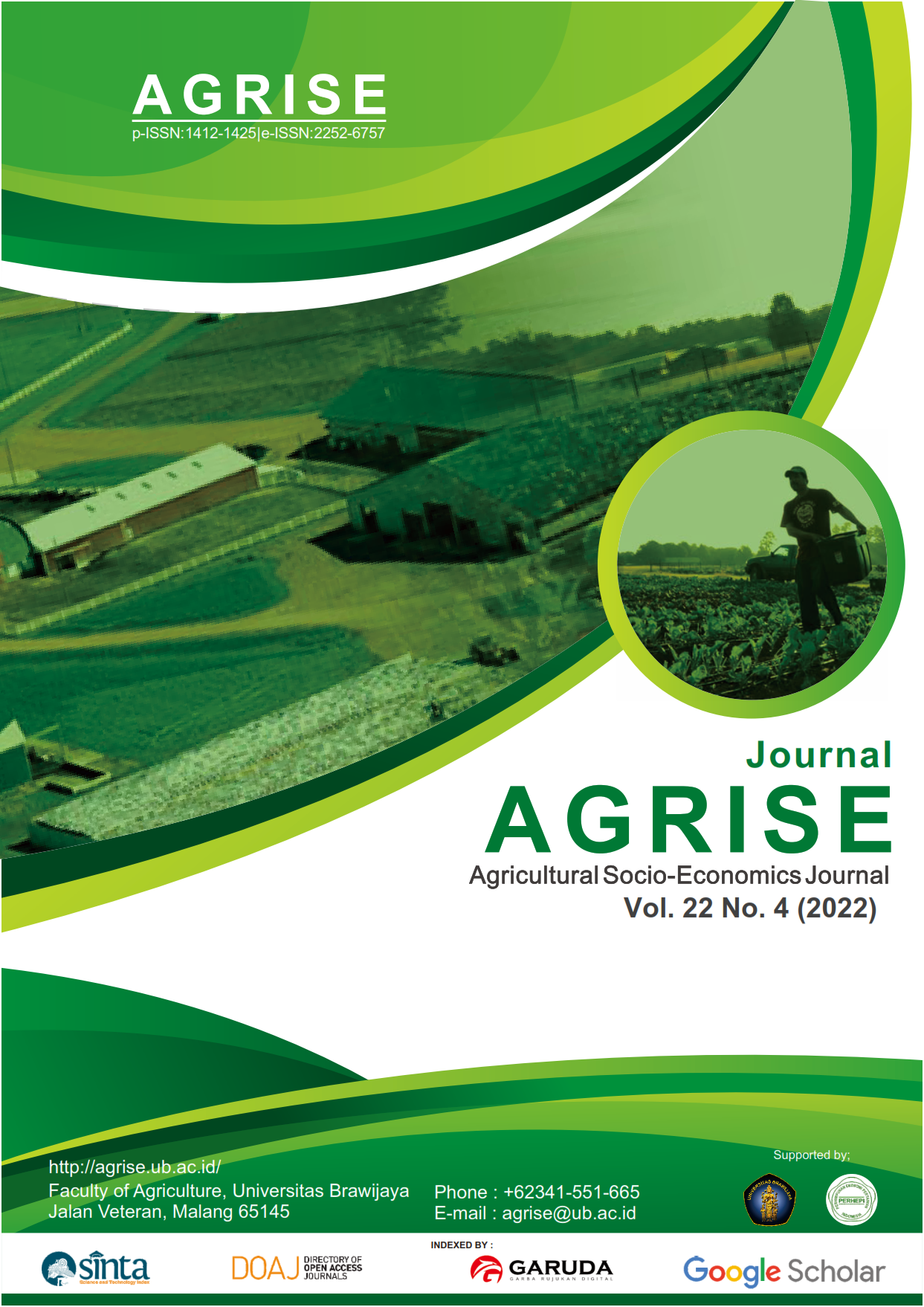THE IMPACT OF HOUSEHOLD CHARACTERISTICS ON THE DEMAND FOR ANIMAL PROTEIN FOOD AWAY FROM HOME IN JAKARTA
DOI:
https://doi.org/10.21776/ub.agrise.2022.022.4.12Keywords:
animal protein, food away from home, household, quantile regression, socioeconomicAbstract
Socio-economic conditions and demographics determine people's lifestyles, including food consumption expenditures. So far, research on food consumption away from home has only used a homogeneous household sample, and only a few have been found in Indonesia. This study aimed to analyze household characteristics' impact on animal protein food expenditure away from home using quantile regression analysis. The study used secondary data consisting of 4,346 household data in Jakarta from SUSENAS March 2020. The results show that spending on animal protein foods away from home in all income quintiles is not affected by household income. It shows that all household groups at various income levels have consumed animal protein foods away from home. Factors that have a positive and significant effect on protein food expenditure away from home are household food expenditure, age of the head of the family, number of family members, wife's education level, and location of residence. The presence of children under the age of 17 has a negative and significant influence. Therefore, it is necessary to monitor and guarantee food safety by producers and consumers to meet the adequacy of protein per capita which is healthy and nutritious.
References
Badan Pusat Statistik. (2019). Laporan Perekonomian Indonesia 2019. Badan Pusat Statistik, 04(01).
Badan Pusat Statistik. (2020). Pengeluaran untuk Konsumsi Penduduk Indonesia, September 2019. In Badan Pusat Statistik. Badan Pusat Statistik. https://doi.org/10.31942/abd.v4i2.3041
Badan Pusat Statistik. (2021a). Laporan Perekonomian Indonesia 2021. Badan Pusat Statistik.
Badan Pusat Statistik. (2021b). Pengeluaran untuk Konsumsi Penduduk Indonesia, September 2020. In Badan Pusat Statistik. https://doi.org/10.29103/tj.v10i2.381
Bai, J., Wahl, T. I., Lohmar, B. T., & Huang, J. (2010). Food away from home in Beijing: Effects of wealth, time and “free†meals. China Economic Review, 21(3), 432–441. https://doi.org/10.1016/j.chieco.2010.04.003
BPS Provinsi DKI Jakarta. (2022). Provinsi DKI Jakarta dalam Angka 2022. https://csirt.jakarta.go.id/portal/profil
Cantillo, J., MartÃn, J. C., & Román, C. (2021). Analysis of the main determinants of away-from-home consumption of fishery and aquaculture products in the EU28. Appetite, 163(March). https://doi.org/10.1016/j.appet.2021.105216
Cupák, A., PokrivÄák, J., & Rizov, M. (2016). Demand for food away from home in Slovakia. Journal of Economics and Finance, 66(4), 354–369. https://doi.org/10.22004/ag.econ.207285
Farfán, G., Genoni, M. E., & Vakis, R. (2017). You are what (and where) you eat: Capturing food away from home in welfare measures. Food Policy, 72(September), 146–156. https://doi.org/10.1016/j.foodpol.2017.08.020
Firpo, S., Fortin, N. M., & Lemieux, T. (2009). Unconditional Quantile Regressions. Econometrica, 77(3), 953–973. https://doi.org/10.3982/ecta6822
Haq, Z. U., Sherif, S., & Gheblawi, M. (2014). Impact of socioeconomic and demographic characteristics of households on demand for Food Away from Home in the United Arab Emirates. International Journal of Hospitality Management, 42, 92–99. https://doi.org/10.1016/j.ijhm.2014.06.011
Hawkes, C., Harris, J., & Gillespie, S. (2017). Urbanization and the nutrition transition. In Global Food Policy Report (Vol. 1, Issue 11, pp. 5–21). International Food Policy Research Institute.
Khan, J., & Mohanty, S. K. (2022). Regional pattern of child undernutrition, calorie consumption, non-food expenditure and wealth in India. Clinical Epidemiology and Global Health, 13(September 2021), 100942. https://doi.org/10.1016/j.cegh.2021.100942
Liu, M., Kasteridis, P., & Yen, S. T. (2013). Breakfast, lunch, and dinner expenditures away from home in the United States. Food Policy, 38(1), 156–164. https://doi.org/10.1016/j.foodpol.2012.11.010
Marshall, S., Burrows, T., & Collins, C. E. (2014). Systematic Review of Diet Quality Indices and Their Associations with Health-related Outcomes in Children and Adolescents. Journal of Human Nutrition and Dietetics, 27(6), 577–598. https://doi.org/10.1111/jhn.12208
Mottaleb, K. A., Rahut, D. B., & Mishra, A. K. (2017). Consumption of food away from home in Bangladesh: Do rich households spend more? Appetite, 119, 54–63. https://doi.org/10.1016/j.appet.2017.03.030
Nurbani, R. I. (2015). Perkembangan Proporsi Pengeluaran Konsumsi Bahan Makanan Masyarakat Indonesia: Seperti Apa Perubahan yang Terjadi? Buletin Newsletter No. 37/2016.
Oyedapo, H. A., Ayeni, O., Afolabi, N. B., & Akinyemi, O. J. (2021). Quantile regression methods for determination of factors associated with nutritional status of women of reproductive age in Nigeria. Scientific African, 14, e00988. https://doi.org/10.1016/j.sciaf.2021.e00988
Powell, L. M., & Nguyen, B. T. (2013). Fast-food and full-service restaurant consumption among children and adolescents: Effecton energy, beverage, and nutrient intake. Journal of American Medical Association, 167(1), 14–20. https://doi.org/10.1001/jamapediatrics.2013.417
Richards, T. J., Mancino, L., & Nganje, W. (2012). Nutrient Demand in Food Away from Home. Forum for Health Economics and Policy, 15(2). https://doi.org/10.1515/1558-9544.1246
Saidah, Yanuar, F., & Devianto, D. (2016). Analisis Regresi Kuantil. Jurnal Matematika UNAND, 5(1), 103. https://doi.org/10.25077/jmu.5.1.103-107.2016
Sangwan, N., & Kumar, S. (2021). Labor force participation of rural women and the household’s nutrition: Panel data evidence from SAT India. Food Policy, 102, 102117. https://doi.org/10.1016/j.foodpol.2021.102117
Downloads
Published
How to Cite
Issue
Section
License
Copyright (c) 2022 Daffa Sandi Lasitya, Ratya Anindita, Syafrial Syafrial

This work is licensed under a Creative Commons Attribution-NonCommercial 4.0 International License.
Authors who publish with this journal agree to the following terms:
- Authors retain copyright and grant the journal right of first publication with the work simultaneously licensed under a Creative Commons Attribution-NonCommercial License that allows others to share the work with an acknowledgment of the work's authorship and initial publication in this journal.
- Authors are able to enter into separate, additional contractual arrangements for the non-exclusive distribution of the journal's published version of the work (e.g., post it to an institutional repository or publish it in a book), with an acknowledgment of its initial publication in this journal.
- Authors are permitted and encouraged to post their work online (e.g., in institutional repositories or on their website) prior to and during the submission process, as it can lead to productive exchanges, as well as earlier and greater citation of published work (See The Effect of Open Access).











